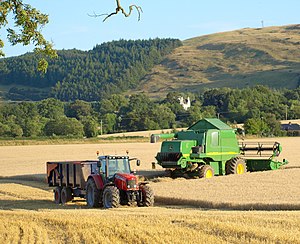
Agriculture in Scotland includes all land use for arable, horticultural or pastoral activity in Scotland, or around its coasts. The first permanent settlements and farming date from the Neolithic period, from around 6,000 years ago. From the beginning of the Bronze Age, about 2000 BCE, arable land spread at the expense of forest. From the Iron Age, beginning in the seventh century BCE, there was use of cultivation ridges and terraces. During the period of Roman occupation there was a reduction in agriculture and the early Middle Ages were a period of climate deterioration resulting in more unproductive land. Most farms had to produce a self-sufficient diet, supplemented by hunter-gathering. More oats and barley were grown, and cattle were the most important domesticated animal. From c. 1150 to 1300, the Medieval Warm Period allowed cultivation at greater heights and made land more productive. The system of infield and outfield agriculture may have been introduced with feudalism from the twelfth century. The rural economy boomed in the thirteenth century, but by the 1360s there was a severe falling off in incomes to be followed by a slow recovery in the fifteenth century.
The early modern era saw the impact of the Little Ice Age, which peaked towards the end of the seventeenth century. The closing decade of the seventeenth century saw a slump, followed by four years of failed harvests, in what is known as the "seven ill years", but these shortages would be the last of their kind. After the Union of 1707 there was a conscious attempt to improve agriculture among the gentry and nobility. Introductions included haymaking, the English plough, new crops, crop rotation and encloses were introduced. The resulting Lowland Clearances saw hundreds of thousands of cottars and tenant farmers from central and southern Scotland lose access to land and either become landless agricultural workers or emigrate to the growing industrial cities or elsewhere. The later Highland Clearances involved the eviction of many traditional tenants as lands were enclosed, principally for sheep farming. In the first phase, many Highlanders were relocated as crofters, living on very small rented farms which required other employment to be found.
In the twentieth century Scottish agriculture became more susceptible to world markets. There were dramatic price rises in the First World War, but a slump in the 1920s and 1930s, followed by more rises in World War II. In 1947 annual price reviews were introduced in an attempt to stabilise the market. There was a drive in UK agriculture to greater production until the late 1970s, resulting in intensive farming. There was increasing mechanisation and farming became less labour-intensive. UK membership of the European Economic Community from 1972 began a change in orientation for Scottish farming. Some sectors became viable only with subsidies. A series of reforms to the CAP from the 1990s attempted to control over-production, limit incentives for intensive farming and mitigate environmental damage. A dual farm structure has emerged with agriculture divided between large commercial farms and small pluralised and diversified holdings.
Roughly 79 per cent of Scotland’s total land area is under agricultural production. Cereals accounted for 78 per cent of cropped land area (not total farmed area), while livestock numbers have been falling in recent years. Around 15 per cent of the total land area of Scotland is forested, most in public ownership controlled by the Forestry Commission. Total income from farming has been rising since the turn of the millennium. Aquaculture production is focused on the West and North of the country. Some farm businesses rely on sources of income other than from farming. Scottish agriculture employs around 1.5 per cent of the workforce and contributes to around 1 per cent of the Scottish economy.
